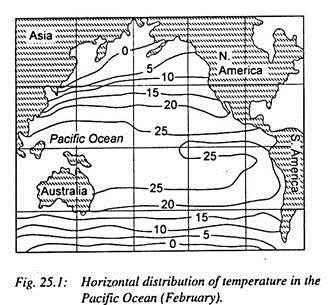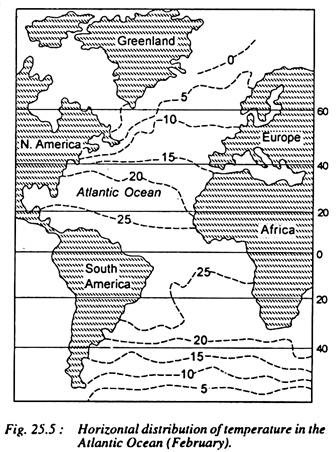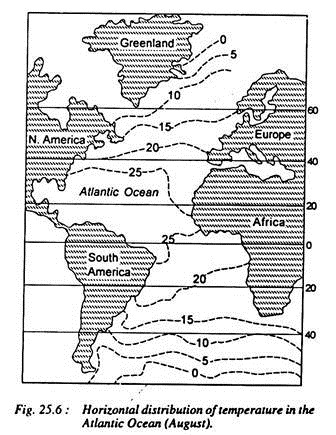ADVERTISEMENTS:
In this article we will discuss about:- 1. Introduction to Temperature of Oceanic Water 2. Range of Temperature of Oceanic Water 3. Distribution Patterns.
Introduction to Temperature of Oceanic Water:
The temperature of the oceanic water is important for marine organisms including plants (phytoplanktons) and animals (zooplanktons). The temperature of sea water also affects the climate of coastal lands and plants and animals therein.
The study of both, surface and subsurface temperature of sea water is significant. Standard type of thermometer is used to measure the surface temperature while reversing thermometers and thermographs are used to measure the subsurface temperature.
ADVERTISEMENTS:
These thermometers record the temperature up-to the accuracy of ±0.02° centigrade. With respect to temperature.
There are three layers in the oceans from surface to the bottom in the tropics viz.:
(i) The first layer represents the top-layer of warm oceanic water and is 500m thick with temperature ranging between 20° and 25°C. This layer is present within the tropics throughout the year but it develops in mid-latitudes only during summer,
(ii) The thermocline layer represents vertical zone of oceanic water below the first layer and is characterized by rapid rate of decrease of temperature with increasing depth,
(iii) The third layer is very cold and extends upto the deep ocean floor. The polar areas have only one layer of cold water from the surface (sea-level) to the deep ocean floor.
ADVERTISEMENTS:
The major source of the temperature of the oceanic water is the sun. The radiant energy transmitted from the photosphere of the sun in the form of electromagnetic shortwaves and received at the ocean surface is called insolation. Besides, some energy, though insignificant, is also received from below the bottom and through the compression of sea water.
The amount of insolation to be received at the sea surface depends on the angle of sun’s rays, length of day, distance of the earth from the sun and effects of the atmosphere. The mechanism of the heating and cooling of ocean water differs from the said mechanism on land because besides horizontal and vertical movements of water, the evaporation is most active over the oceans.
Range of Temperature of Oceanic Water:
Daily Range of Temperature:
ADVERTISEMENTS:
The difference of maximum and minimum temperature of a day (24 hours) is known as daily range of temperature. The daily range of temperature of surface water of the oceans is almost insignificant as it is around 1°C only. On an average, the maximum and minimum temperatures of sea surface water are recorded at 2 P.M. and 5 A.M. respectively. The daily range of temperature is usually 0.3°C in the low latitudes and 0.2° to 0.3°C in high latitudes.
The diurnal range depends on the conditions of sky (cloudy or clear sky), stability or instability of air and stratification of seawater. The heating and cooling of ocean water is rapid under clear sky (cloudless) and hence the diurnal range of temperature becomes a bit higher than under overcast sky and strong air circulation. The high density of water below surface water causes very little transfer of heat through conduction and hence the diurnal range of temperature becomes low.
Annual Range of Temperature:
The maximum and minimum annual temperatures of ocean water are recorded in August and February respectively (in the northern hemisphere). Usually, the average annual range of temperature of ocean water is -12°C (10°F) but there is a lot of regional variation which is due to regional variation in insolation, nature of seas, prevailing winds, location of seas etc. Annual range of temperature is higher in the enclosed seas than in the open sea (Baltic Sea records annual range of temperature of 4.4°C or 40°F).
The size of the oceans and the seas also affects annual range of temperature e.g., bigger the size, lower the annual range and vice versa. The Atlantic Ocean records relatively higher annual range of temperature than the Pacific Ocean.
Distribution Patterns of Temperature of Oceanic Water:
The distributional pattern of temperature of ocean water is studied in two ways viz.:
(i) Horizontal distribution (temperature of surface water), and
(ii) Vertical distribution (from surface water to the bottom).
Since the ocean has three dimensional shapes, the depth of oceans, besides latitudes, is also taken into account in the study of temperature distribution.
ADVERTISEMENTS:
The following factors affect the distribution of temperature of ocean water:
(1) Latitudes:
The temperature of surface water decreases from equator towards the poles because the sun’s rays become more and more slanting and thus the amount of insolation decreases poleward accordingly. The temperature of surface water between 40°N and 40°S is lower than air temperature but it becomes higher than air temperature between 40th latitude and the poles in both the hemispheres.
(2) Unequal distribution of land and water:
The temperature of ocean water varies in the northern and the southern hemispheres because of dominance of land in the former and water in the latter. The oceans in the northern hemisphere receive more heat due to their contact with larger extent of land than their counterparts in the southern hemisphere and thus the temperature of surface water is comparatively higher in the former than the latter.
The isotherms are not regular and do not follow latitudes in the northern hemisphere because of the existence of both warm and cold land- masses whereas they (isotherms) are regular and follow latitudes in the southern hemisphere because of the dominance of water. The temperature in the enclosed seas in low latitudes becomes higher because of the influence of surrounding land areas than the open seas e.g., the average annual temperature of surface water at the equator is 26.7°C (80°F) whereas it is 37.8°C (100°F) in the Red Sea and 34.4°C (94°F) in the Persian Gulf.
(3) Prevailing wind:
Wind direction largely affects the distribution of temperature of ocean water. The winds blowing from the land towards the oceans and seas (e.g., offshore winds) drive warm surface water away from the coast resulting into upwelling of cold bottom water from below. Thus, the replacement of warm water by cold water introduces longitudinal variation in temperature. Contrary to this, the onshore winds pile up warm water near the coast and thus raise the temperature.
For example, trade winds cause low temperature (in the tropics along the eastern margins of the oceans or the western coastal regions of the continents) because they blow from the land towards the oceans whereas these trade winds raise the temperature in the western margins of the oceans or the eastern coastal areas of the continents because of their onshore position.
Similarly, the eastern margins of the oceans in the middle latitudes (western coasts of Europe and North America) have relatively higher temperature than the western margins of the oceans because of the onshore position of the westerlies.
(4) Ocean currents:
Surface temperatures of the oceans are controlled by warm and cold currents. Warm currents raise the temperature of the affected areas whereas cool currents lower down the temperature. For example, the Gulf Stream raises the temperature near the eastern coasts of N. America and the western coasts of Europe.
Kuro Shivo drives warm water away from the eastern coast of Asia and raises the temperature near Alaska. Labrador cool current lowers down the temperature near north-east coast of N. America. Similarly, the temperature of the eastern coast of Siberia becomes low due to Kurile cool current.
It may be mentioned that warm currents raise the temperature more in the northern hemisphere than in the southern hemisphere which is apparent from the fact that the 5°C isotherm reaches 70° latitude in the northern Atlantic Ocean whereas it is extended up to only 50° latitude in the southern Atlantic Ocean. This is because of more dominant effects of the warm Brazil current in the southern Atlantic Ocean.
(5) Minor Factors:
Minor factors include:
(i) submarine ridges,
(ii) local weather conditions like storms, cyclones, hurricanes, fog, cloudiness, evaporation and condensation, and
(iii) location and shape of the sea.
Longitudinally more extensive seas in the low latitudes have higher temperature than the latitudinally more extensive seas as the Mediterranean Sea records higher temperature than the Gulf of California.
The enclosed seas in the low latitudes record relatively higher temperature than the open seas whereas the enclosed seas have lower temperature than the open seas in the high latitudes (Baltic Sea records 0°C (32°F) and open seas have 4.4°C or 40°F).
Horizontal Distribution of Temperature:
On an average, the temperature of surface water of the oceans is 26.7°C (80°F) and the temperature gradually decreases from equator towards the poles. The rate of decrease of temperature with increasing latitudes is generally 0.5°F per latitude. The average temperatures become 22°C (73°F) at 20° latitude, 14°C (57°F) at 40° latitude, and 0°C (32°F) near the poles.
The oceans in the northern hemisphere record relatively higher average temperature than in the southern hemisphere. The highest temperature is not recorded at the equator rather it is a bit north of it. The average annual temperature of all the oceans is 17.2°C (63°F).
The average annual temperatures for the northern and southern hemispheres are 19.4°C (67°F) and 16.1°C (61°F) respectively. The variation of temperatures in the northern and southern hemispheres is because of unequal distribution of land and ocean water.
The decrease of temperature with increasing latitudes in the northern Atlantic Ocean (figs. 25.5 and 25.6) is very low because of warm ocean currents. The average temperature between 50°-70°N latitudes is recorded as 5°C (41°F). The decrease of temperature with increasing latitudes is more pronounced in the southern Atlantic Ocean. According to Krumel the highest temperature of surface water of the oceans is at 5°N latitude whereas the lowest temperature is recorded between 80°N and the north pole and between 75°S and the south pole.
The average annual temperature of the Pacific Ocean is slightly higher than the Atlantic Ocean (16.91 °C or 60°F) and the Indian Ocean (17°C or 60.6°F). The lowest (3.3°C or 35.94°F) and the highest (32.2°C or 89.96°F) temperatures of the oceans are recorded near New Scotland and in the western Pacific Ocean respectively.
The highest temperature of the Indian ocean (25°C or 82.4°F) is recorded in the Arabian Sea and Bay of Bengal but the enclosed seas of the Indian Ocean record still higher temperatures (Red Sea = 32.2°C or 90°F and Persian Gulf = 34.4°C or 94°F). The average seasonal temperatures (February and August) of surface water of the oceans have been represented through isotherms (figs. 25.1,2,3,4, 5 and 6).
The temperature of the surface water of the oceans is higher than the air temperature above the ocean surface which means ocean surface gives off heat to the atmosphere. This phenomenon influences the generation of oceanic circulation mainly sea waves and ocean currents.
It has been observed that the air temperature at the height of 8m from the sea surface between 20°N and 55°S latitudes in the Atlantic Ocean is cooler by 0.80°C than the sea surface. There is a lot of variation in the heat emitted from the oceans to the atmosphere during winter and summer and this phenomenon causes differences of air temperature over the oceans and the continents mainly during winter season.
‘The temperature for January is 22.2°C higher over the oceans between 20° and 80°N, while in July it is 4.8°C lower. The mean annual temperature is 7°C higher over the water meridian’. The difference between air and sea surface temperatures causes fogs over the seas and the oceans.
This happens when warm air passes over a cold sea surface having the temperature below dew point of the air. Consequently the air over the sea surface is cooled from below and sea fog occurs. Generally, sea fogs are frequently formed during spring and early summer because air coming from over the land is warmer while the sea surface is still cold. Sea fogs are very common in the high latitudes but are generally absent in the tropics.
Vertical Distribution of Temperature:
It may be pointed out that maximum temperature of the oceans is always at their surface because it directly receives the insolation and the heat is transmitted to the lower sections of the oceans through the mechanism of conduction. In fact, the solar rays very effectively penetrate upto 20m depth and they seldom go beyond 200m depth.
Consequently, the temperature decreases from the ocean surface with increasing depth but the rate of decrease of temperature with increasing depth is not uniform everywhere. The temperature falls very rapidly upto the depth of 200m and thereafter the rate of decrease of temperature is slowed down.
From this stand point the oceans are vertically divided into two zones:
(1) Photic or euphotic zone represents the upper surface up to the depth of 200m and receives solar radiation.
(2) Aphotic zone extends from 200m depth to the bottom and does not receive solar rays.
The following are the salient features of vertical distribution of temperature of ocean water:
1. Though the sea temperature decreases with increasing depth but the rate of decrease of temperature is not uniform. The change in sea temperature below the depth of 2000m is negligible.
The following trend of decrease in temperature with increase in depth has been reported by Murray during his Challenger Expedition:
2. Diurnal and annual ranges of temperature cease after the depth of 5 fathoms (30 feet) and 100 fathoms (600 feet) respectively.
3. The rate of decrease of temperature with increasing depth from equator towards the poles is not uniform. Though the surface temperature of the seas decreases from equator towards the poles but the temperature at the ocean bottoms is uniform from the equator towards the pole, which means that the rate of decrease of temperature with increasing depth is more rapid near the equator than towards the poles.
The result of German Antarctic Expedition in 1911 revealed that the temperature at the depth of 100m at 7.30°N latitude equalled the surface temperature at 40°N latitude. Similarly, the temperature at 200m depth at 7.30°N latitude equalled the temperature of sea surface at50°N latitude and the temperature at the depth of 700- 800m was the same as it was at the surface at 60°N latitude.
Table 25.3 reveals these trends:
4. The areas from where sea surface water is driven away by offshore winds resulting into upwelling of water from below record low temperature at sea surface and thus the rate of decrease of temperature with increasing depth becomes low. Contrary to this the areas where there is pilling of sea water because of onshore winds, record relatively high temperature at sea surface and thus the rate of decrease of temperature with increasing depth becomes rapid.
In some areas high temperature is recorded at greater depths e.g., in Sargasso Sea, Red Sea, Mediterranean Sea, Sulu Sea etc. The Mediterranean Sea records 24.4°C at the depth of 1,829m whereas the Indian Ocean has only 1.1°C temperature at the same depth. Such anomalous conditions are noticed in the enclosed seas of low latitudes. The enclosed seas of high latitudes register inversion of temperature i.e., the temperature of sea surface is lower than the temperature below.
5. There is clear-cut leyered thermal structure of ocean water.
Vertically the oceans are divided into 3 layers from the stand point of thermal conditions of seawater, in the lower and middle latitudes as follows:
(1) The upper layer represents the top-layer of warm water mass with a thickness of 500 meters with average temperature ranging between 20°C to 25°C. This lighter ocean water mass floats over the thickest heavy water mass of the oceans extending up to the ocean bottoms. This layer is present within the tropics throughout the year but it develops in middle latitudes only during summer season.
(2) The lower layer extends beyond 1000m depth up to the ocean bottoms. This layer is very cold and represents denser ocean water mass.
(3) The upper and lower ocean water masses are separated by a transitional zone of rapid change of temperature with increasing depth. This zone of ocean water mass is called thermocline which extends between 300m-1000m depth.
Besides, there are seasonal thermoclines between the depth of 40m and 100m.
These seasonal thermoclines are formed due to heating of water surface through solar radiation during summer season. There are also diurnal thermoclines which form in shallow water depth usually less than 10-15m. The polar seas have only one layer of cold water mass from the ocean surface (sea level) to the deep ocean floor.









